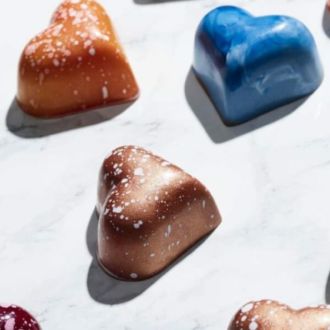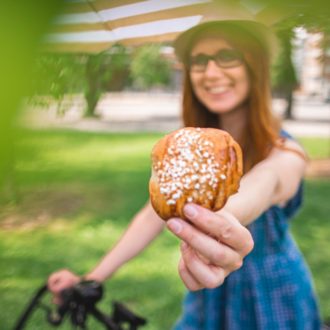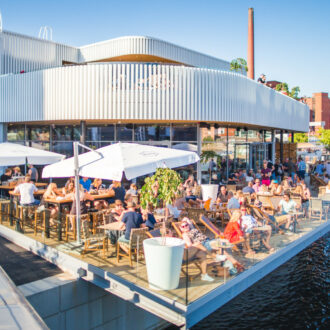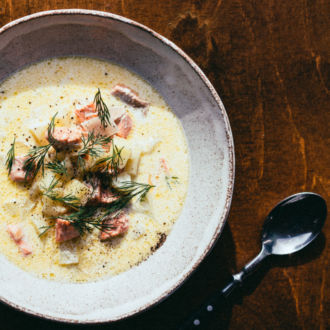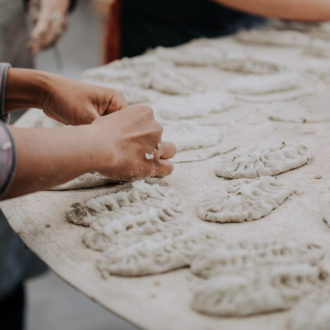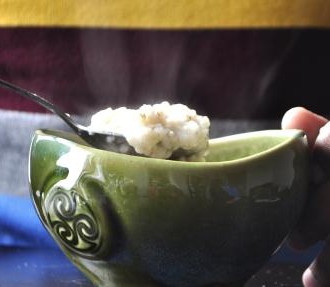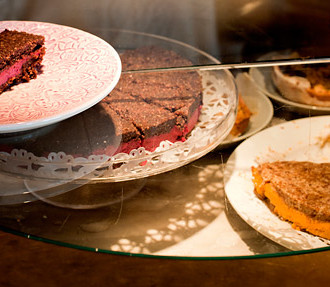They’re both the same colour (brown), and the Finns consider them both Easter delicacies. Mämmi has hundreds of years of history, while Mignon eggs have existed for only about a century and a quarter.
Manufactured by Finnish confectioner Fazer since 1896, Mignon eggs are easy to love. Although many people nonchalantly refer to them as chocolate eggs, their filling is technically not chocolate – it’s a smooth, milk-free, chocolatey blend of cocoa, almonds and hazelnuts. Mämmi, a pudding-like substance made from rye malt and rye flour, is a food that non-Finns often find more difficult to fall for.
Fazer likes to say that its Mignon eggs (the word means “cute” in French) are handmade. The company uses real eggshells, filling them with a liquefied cocoa mixture that later solidifies. That’s the part that they do by hand, holding one eggshell at a time under a faucet, a little bit like something you’d see in a movie about Willy Wonka. They also have to pack the eggs manually to avoid cracking them.
You can’t eat Fabergé eggs
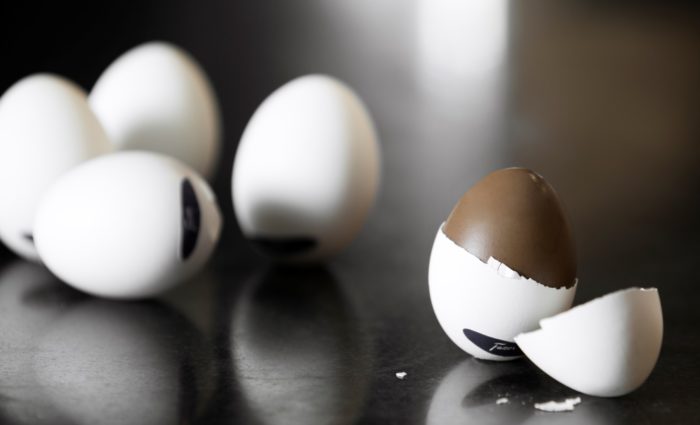
You peel a Mignon like a regular egg, but it contains a solid, chocolatey confection.Photo: Kristiina Hemminki/Fazer
Legend has it that Tsar Nicholas II was one of the first famous fans of Mignon eggs and made them an Easter tradition at his court in Saint Petersburg. Nowadays Fazer produces more than 1.5 million of them each year, enough to fill 23 transport trucks. For the employees who fill and stack the eggs, the season lasts from November through March.
In order to eat a Mignon, the customer has to peel it like a hard-boiled egg, revealing a round, solid, chocolatey confection. In one Finnish family we know of, the father used to insist to the kids that Mignon shells were actually made of sugar (they’re not, except for the solid sugar covering the hole used for the filling). He would also eat the shell to prove his point.
Don’t try that at home, but for anyone who likes to decorate, dye or paint eggs for Easter, Mignons are great: they don’t need to be cooked or emptied, they don’t smell ugly, they keep longer and, we think you’ll agree, they taste better than regular eggs.
Nutritious consistency
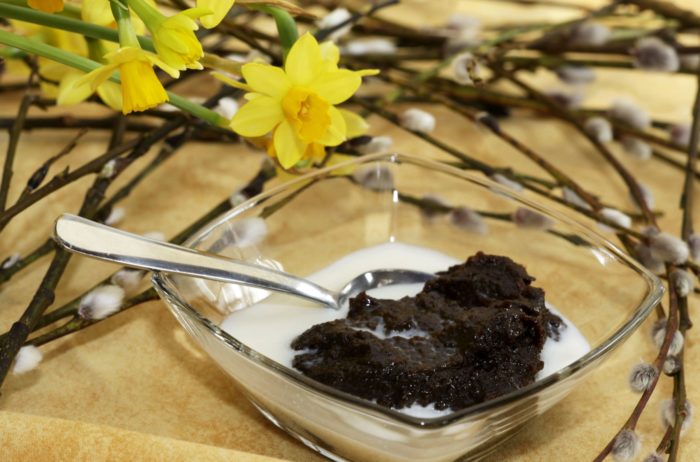
Mämmi has a consistency somewhere between cake batter and cookie dough, and is usually served with cream. Daffodils and budding willow branches are also associated with Easter, as the holiday often happens just as these signs of spring are appearing.Photo: Soili Jussila/Lehtikuva
The attraction of mämmi is more difficult to explain, but it’s definitely nutritious. Its consistency lies somewhere between cake batter and cookie dough, which sort of suits the name, with its multiple m’s that make it feel like your lips are sticking together. Saying it in Swedish, the country’s other major language (Finland is officially bilingual), produces much the same effect: memma.
It tastes pleasant, but visually it resembles – there’s really no nice way to put this, so let’s just say it tastes better than it looks. People often pour cream over their mämmi and sprinkle sugar on top, which contributes to the taste but doesn’t improve the appearance.
A Finnish invention, mämmi is generally available only in Finland and Sweden, which is home to approximately half a million people of Finnish descent, about five percent of that country’s population. One other similar dish exists: samanu, made by a similar process from wheat instead of rye, is associated with Nowruz, the Persian New Year celebration, held every March.
If you value a connection with history, mämmi offers a tradition that stretches back to at least the 1600s and possibly as far as the 1100s. It is prepared by baking but can be stored cold for many days; this made it a perfect fit for Good Friday, when custom forbade lighting a fire and cooking food.
Mämmi is also healthy – at least before you add cream and sugar, but even then. It is rich in protein and fibre from the rye; depending on the recipe, it contains approximately five percent protein and eight percent fibre. It also conveys an array of minerals and B vitamins.
The many manifestations of mämmi
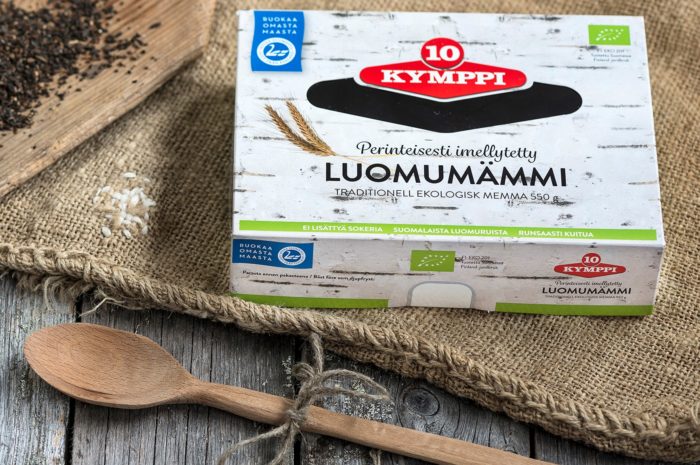
Many brands, varieties and flavours of mämmi appear in Finnish grocery stores; shown here is organic mämmi. Birch-bark patterns often appear in the packaging, alluding to the birch-bark trays that people traditionally used to serve this Easter delicacy.Photo courtesy of Kymppi-Maukkaat
Multiple brands are available at any store during the Easter season, usually packaged in compact disposable trays holding about 500 grams (a little more than a pound), but any way you present it, it lacks the cuteness factor of chocolate eggs. However, that hasn’t stopped the Finns from getting creative with mämmi in various desserts, main dishes and beverages. Sampling Finnish food blogs and grocery stores, you can find berry mämmi, potato mämmi, coffee mämmi, vanilla mämmi, mämmi-mango dessert platters, mämmi yogurt, mämmi-liquorice ice cream, mämmi cheesecake, mämmi custard buns, mämmi lemon-custard pie, mämmi chocolate cake, mämmi mousse, mämmi-orange parfait and several kinds of mämmi bread, not to mention mämmi cream stout beer.
You can find Finnish people who can’t stand mämmi, but the majority of them seem to like it – once a year, in any case. For recent arrivals to the country who are experiencing their first Finnish Easter, mämmi represents a kind of rite of passage. You have to taste it first – then you can criticise it, defend it, or just reserve judgement, as the case may be.
The Finns buy more than 1.7 million kilograms (3.7 million pounds) of mämmi per year, most of it around Eastertime. This means more than a kilogram (2.2 pounds) of mämmi for every Mignon egg sold. How about this: Has anyone tried manufacturing mämmi-filled chocolate eggs? They’d be sure to become a hit in Finland.
By ThisisFINLAND staff


